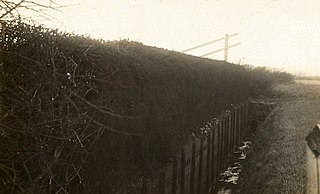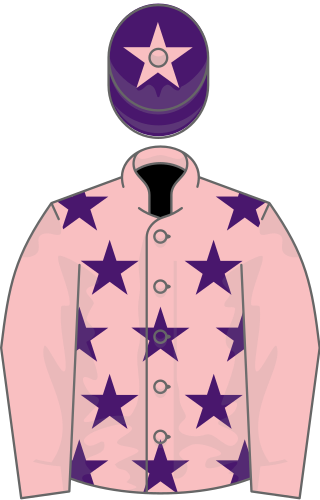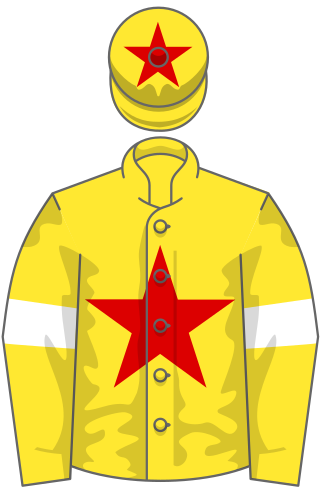Related Research Articles

The Grand National is a National Hunt horse race held annually at Aintree Racecourse in Liverpool, England. First run in 1839, it is a handicap steeplechase over an official distance of about 4 miles and 2½ furlongs, with horses jumping 30 fences over two laps. It is the most valuable jump race in Europe, with a prize fund of £1 million in 2017. An event that is prominent in British culture, the race is popular amongst many people who do not normally watch or bet on horse racing at other times of the year.

Aintree Racecourse is a racecourse in Aintree, Metropolitan Borough of Sefton, Merseyside, England, bordering the city of Liverpool. The racecourse is the venue for the Grand National steeplechase, which takes place annually in April over three days. Aintree also holds meetings in May and June, October (Sunday), November and December.

Becher's Brook is a fence jumped during the Grand National, a National Hunt horse race held annually at Aintree Racecourse near Liverpool, England. It is jumped twice during the race, as the 6th and 22nd fence, as well as on four other occasions during the year. It has always been a notorious and controversial obstacle, because of the size and angle of the 6 ft 9in drop on the landing side. Some jockeys have compared it to "jumping off the edge of the world."

The 2001 Grand National was the 154th official running of the Grand National horse race that took place at Aintree Racecourse near Liverpool, England, on 7 April 2001. It went ahead as planned, despite the cancellation of the 2001 Cheltenham Festival, caused by the foot-and-mouth disease crisis.
The 1836 Grand Liverpool Steeplechase was the first of three unofficial annual precursors of a steeplechase which later became known as the Grand National.
The 1838 Grand Liverpool Steeplechase was the last of three unofficial annual precursors of a Handicap Steeple-chase, later to become known as the Grand National Steeplechase horse race which took place at Aintree Racecourse near Liverpool on Monday 5 March 1838 and attracted a field of only three runners. This race did not carry the prestige of the future Grand Nationals and its status as an official Grand National was revoked some time between 1862 and 1873.
Martin William Becher was a former soldier and steeplechase jockey in whose memory the Becher's Brook obstacle at Aintree Racecourse is named.

The 1998 Grand National was the 151st official renewal of the world-famous Grand National steeplechase that took place at Aintree near Liverpool, England, on 4 April 1998.

The 1994 Grand National was the 147th official renewal of the Grand National horse race that took place at Aintree near Liverpool, England, on 9 April 1994.
The 1967 Grand National was the 121st renewal of the world-famous Grand National steeplechase that took place at Aintree Racecourse near Liverpool, England, on 8 April 1967. The race is best remembered for being won by outsider Foinavon at odds of 100/1, after being the only horse to avoid a mêlée at the 23rd fence and jump it at the first attempt.

The 1990 Grand National was the 144th renewal of the Grand National horse race that took place at Aintree Racecourse near Liverpool, England, on 7 April 1990. The off time was 3.20pm.

The 1989 Grand National was the 143rd renewal of the Grand National horse race that took place at Aintree Racecourse near Liverpool, England, on 8 April 1989.

The 1988 Grand National was the 142nd renewal of the Grand National horse race that took place at Aintree Racecourse near Liverpool, England, on 9 April 1988.

The 2012 Grand National was the 165th annual renewal of the Grand National horse race at Aintree Racecourse near Liverpool, England. The showpiece steeplechase, which concluded a three-day meeting which is one of only four held at Aintree throughout the year, took place on 14 April 2012. The maximum permitted field of 40 runners ran the last 4 miles 856 yards (7.220 km) of Aintree's National Course featuring 30 fences, competing for record prize money of £975,000, making it the highest-valued National Hunt race in the United Kingdom.
The 1979 Grand National was the 133rd renewal of the Grand National horse race, which took place at Aintree near Liverpool, England, on 31 March 1979.
The 1951 Grand National was the 105th renewal of the Grand National horse race that took place at Aintree Racecourse near Liverpool, England, on 7 April 1951.
The 1851 Grand National was, at the time, the 14th renewal of a handicap steeplechase horse race that took place at Aintree near Liverpool, England, on 26 February 1851. However, this was later retrospectively recorded as the 13th official running by the Steeplechase Calendar of 1864 when the race of 1838 was disregarded as official.

The 2013 Grand National was the 166th annual running of the Grand National horse race at Aintree Racecourse near Liverpool, England. The showpiece steeplechase, which concluded a three-day meeting, took place on 6 April 2013. The maximum permitted field of 40 runners competed for a share of the £975,000 prize fund, which made the National the most valuable jump race in Europe.

The 2018 Grand National was the 171st annual running of the Grand National horse race at Aintree Racecourse near Liverpool, England. The showpiece steeplechase was the pinnacle of a three-day festival which commenced on 12 April 2018. The event was sponsored by Randox Health for the second time.
References
- ↑ Vamplew, Wray & Kay, Joyce. (2004). Encyclopedia of British Horseracing. Routledge. p. 211. ISBN 978-0-7146-5356-3